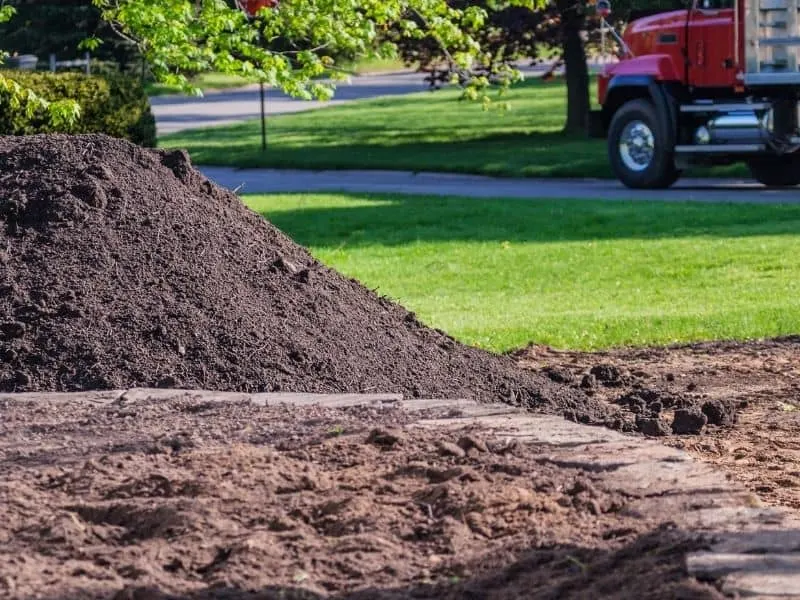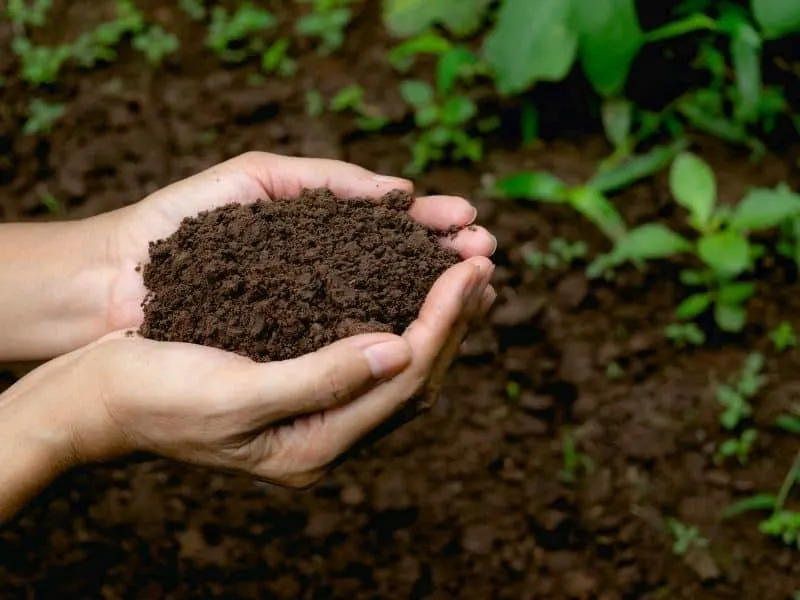Do-it-yourself landscaping and garden building can provide a fun creative outlet as well as a low-cost way to beautify your outdoor space. However, navigating the endless choices for materials can be mind-boggling. When you reach a step that requires soil, which kind should you use? To help you decide on the best soil for your project, this article discusses topsoil vs compost, including the differences between them, the benefits and disadvantages of each, and when to use one or the other.

Topsoil vs Compost
What is topsoil?

If you go to the woods and take a close look at the ground, you will see a layer of dead leaves and other decaying matter: this is the O horizon. Directly beneath this layer is the humus-rich A horizon, otherwise known as topsoil. These layers exist in other environments as well, though factors like slope, water drainage, and erosion can make them thinner or thicker or eliminate them altogether, exposing the layers beneath.
Although healthy topsoil is loamy and organically rich, the stuff you buy or dig up may not be. Premium-grade topsoil has been screened for rocks and weed seeds and should have a good texture and organic content. The economy grade, on the other hand, will generally be of lower quality and likely not screened.
Pros of topsoil
- Adds volume and levels out uneven areas
- Suitable for a range of landscaping and gardening projects
- Often inexpensive when purchased in bulk
Cons of topsoil
- May not improve soil texture if purchased locally
- Not always 100% free of weeds and other contaminants
- Typically must be purchased
What is compost?

Returning to the natural layers of healthy soil, compost would be the O horizon. In a garden, this translates to decomposed organic matter — vegetable and fruit peels, eggshells, other food scraps, leaves, grass clippings, and even shredded paper or cardboard. This nutrient-rich “black gold” is typically used as an amendment rather than on its own.
Unlike topsoil, you can choose to make your own compost. This is a great low-cost (free!) option if you don’t need it right away, though of course if you do, you can always purchase some now and start a compost pile for later use. As an added bonus, composting reduces the amount of waste you send to the landfill.
Pros of compost
- Serves as a nutrient-rich, multipurpose soil amendment
- Can be made for free (learn how to make organic compost)
- Keeps food waste and other organic materials out of landfills
Cons of compost
- Takes time to make
- Can be expensive when purchased
- It may contain weed seeds
The 4 best uses for topsoil
You will generally need topsoil when creating something new, especially if you want to add bulk. Lower-quality topsoil, or fill dirt, can be used for filling, leveling, and other applications where seeds and rocks are not a concern. For most other projects, you will want general-purpose or even economy-grade topsoil.
1. Establish new garden beds

The use of topsoil in creating an herb or vegetable garden will depend on your chosen method and the quality of the existing soil. If you plan on tilling the area and have good soil, you likely don’t need to add any topsoil.
However, if you have poor soil – whether it’s clay soil, sandy soil, or just bedrock – a few inches of quality topsoil may help improve the texture. Topsoil is also a helpful ingredient in some no-till techniques, such as lasagna gardening.
2. Establish new raised beds

Raised beds can take a bit of work to build, but they offer many benefits once established. After you construct frames for your beds, you will need something to fill them with, and screened topsoil is a great place to start.
Depending on the amount of organic matter present in the topsoil, you may even be able to plant directly into it without any amendments the first year.
3. Establish new landscape beds

Again, the use of topsoil in creating new landscape beds depends on the existence and quality of the existing soil. If you do need to add topsoil, keep in mind that landscaping plants have a wide range of soil needs, which you will want to consider before filling all of the beds with unsuitable soil.
Additionally, native plants are adapted to native soil, so make sure to use local topsoil for native plants, if needed. To learn more about native plants, read Bringing Nature Home: amazing!
4. Establish a new lawn

When establishing a new lawn on an eroded site or poor soil, it is helpful to first add a few inches of topsoil. This also allows you to smooth out any uneven ground. Typically, a three to six-inch layer of topsoil should be sufficient, though of course, you will need a bit more if you are also leveling out dips and ripples.
The 4 best uses for compost
The main purpose of compost is to improve topsoil. It can aerate heavy clay soils, add structure to silt and sand, and balance pH and add nutrients to all soil types. To avoid overwhelming plants with “too much of a good thing,” compost should almost always be mixed into the topsoil or another growing medium to create healthy garden soil or potting mix.
1. Amend garden beds
You can offer your vegetables and herbs a nutritional boost when creating a vegetable plot or raised bed garden by mixing in about two to three inches of compost. Then each year, add an additional layer to replace the nutrients used by the plants; either leave it on top of the soil to act as mulch or rake it into the top four to six inches.
2. Amend landscape beds
Before adding compost to landscape beds, consider what types of plants you would like to grow or are already growing. While some will greatly benefit from the addition of compost, others may prefer less fertile soil and respond negatively to the abundance of organic matter.
The best practice might be to add compost as you plant species that appreciate nutrient-rich soil and then top dress around them as necessary to replenish nutrients.
3. Amend lawn
If you use high-quality topsoil when establishing your lawn, you likely won’t need to add any compost before seeding it. However, it can be beneficial in your regular chemical-free maintenance routine. Sprinkle a thin, quarter- to half-inch layer of compost over the lawn twice each year to increase aeration, improve nutrient levels, and prevent the creation of a deep thatch layer.
4. Blend potting mix
While purchasing bagged potting mix from a local garden center is often the most convenient option, blending your own allows for customization and may actually be cheaper if you use your own compost.
A plethora of recipes exist with varying ingredients, ratios, and applications, so I encourage you to try a few different options based on your needs and available resources to see which works best for you.
Which is the best option?
So is compost or topsoil better? This feels like a trick question because of course, it depends on what you need it for. In general, use topsoil to add bulk and compost to add nutrients, keeping in mind all of the tips listed above. Happy gardening!


How To Celebrate Learn About Composting Day On May 29
Tuesday 16th of August 2022
[…] Learn about topsoil vs compost. […]